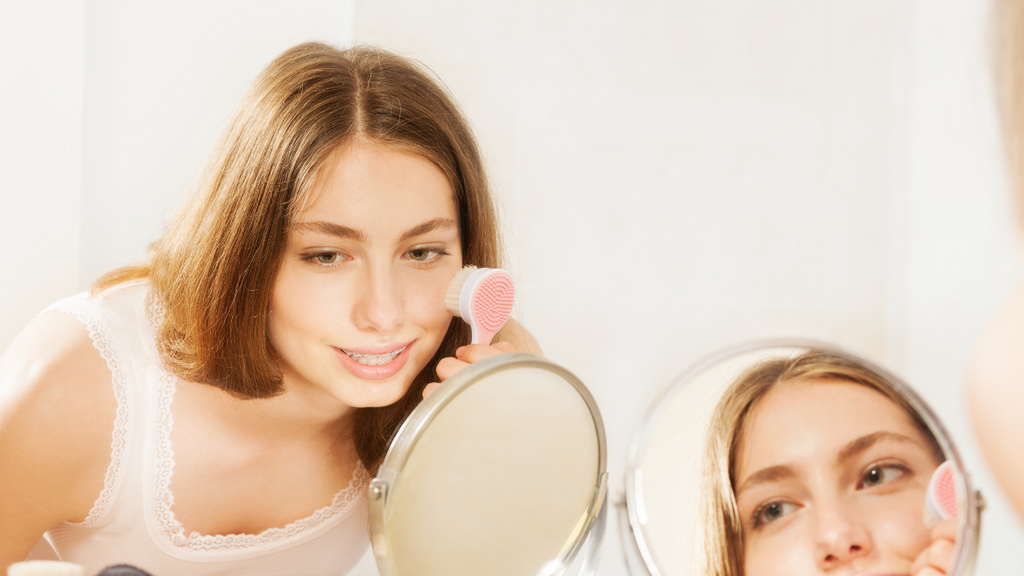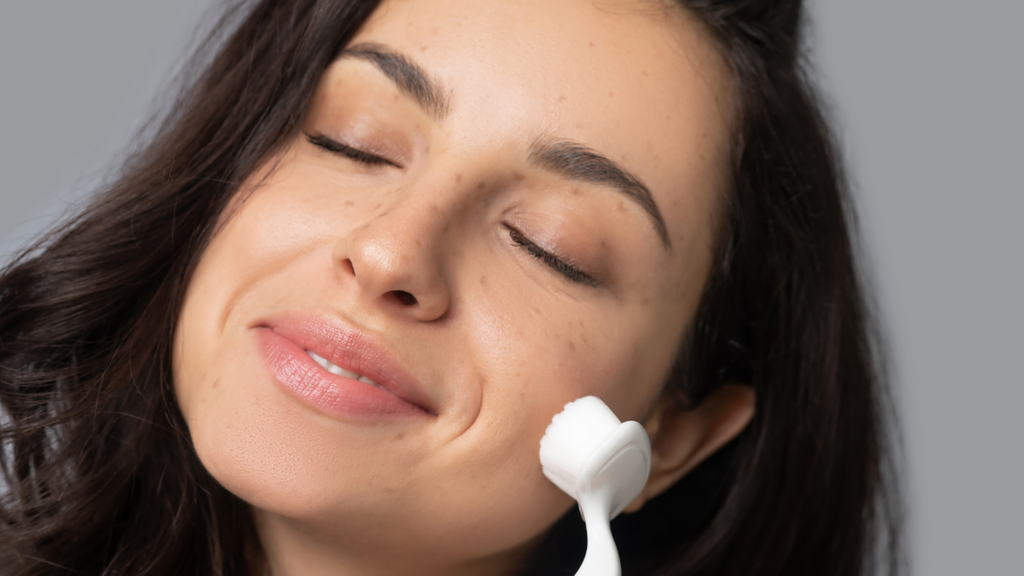Do you ever go down the rabbit hole that is a 10X magnifying mirror? If you’re anything like me, this exercise can be a weekly venture of horror. You find the stray hairs – I mean how exactly do those long white ones go unnoticed and then suddenly grow 12 feet long? – the blocked pores, red patches, flaky skin, and wonder, “Can others see these complexion flaws?” The answer is “No, they can’t!” These mirrors highlight your “problem areas” at an extreme magnification level and the human eye just isn’t that good! But when you’re up close and personal with your face, larger than life, you might notice uneven skin texture, uneven colour, flaky, broken and dry skin and if you apply your foundation at this level of magnification, you might find globules of product sticking to patches of skin that cannot be blended in if your life depended on it. Why oh why you might ask the good skin gods? Why do some people look oh so Instagrammable and I’m left with a flake on the end of my nose? The answer might be filters or it might be that they just have discovered the holy grail of serums and moisturisers and foundations or it might be this new trend of dry body brushing.
Let’s explore what dry brushing is – for face and body – and is it beneficial for getting that glowy, smooth-textured, perfectly moisture-balanced skin?
What is dry brushing?
You may find that your skin is dry and flaky and your foundation is sticking to dry spots or peeling off. Is it because you’re applying your firming serum first? Is the foundation past its best? Is this normal and are there any solutions?
Dry brushing is a technique of gently exfoliating the skin using a special firm-bristled brush. That’s it! A simple yet effective solution for this common problem.
These “magical” brushes come in a variety of options from smaller ones with handles for the face to longer ones that can reach the back to medium-sized handheld ones for the body. They’re usually made of wood with natural bristles formed from plant fibres like sisal (which comes from agave). They have varying price points but usually cost around £5-15.
Many people use dry brushing as part of their weekly skin routine, around two to three times per week, to rid themselves of skin flaking, restore firmness, and encourage blood flow.
The body and the face can be dry brushed and there are various benefits associated with the practice.

Why is dry brushing beneficial?
Dry brushing has its roots in a tenet of Ayurveda, which was the medical system of ancient India, originating over five millennia ago. Rituals such as drinking hot lemon water to flush toxins, dry brushing, tongue scraping, and oil pulling all came from Ayurveda wellness practices.
The purported benefits of dry brushing are as follows:
- Exfoliation
- Dead skin removal
- Unclogging pores
- Lymphatic drainage
- Wrinkle reduction
- Increased circulation
- Energizing
- Softer, smoother skin
It’s recommended to dry brush before you have a hot bath or shower. Only use dry brushes on clean skin, especially when dry brushing on the face. Don’t press too hard or overdo it because it can irritate the skin. Although it’s a perfectly safe practice, you want to be gentle and follow up any brushing with moisturiser.

How to use a dry brush on your face
Follow these easy steps for dry brushing your face:
- Use an appropriate dry brushing face tool like this Hydrea one from Look Fantastic for a fiver or this Goop one from Cult Beauty for £18.
- Begin with a clean, dry face. You can use our facial cleanser which doesn’t require water and can be applied and removed with a cotton pad (or eco-friendly alternative) and leaves your skin clean and moisturised.
- Start brushing downward in circular motions or in short strokes at the top of your face down towards your heart. Brush your forehead from the bridge of your nose up to your hairline and back towards the ears.
- Repeat the brushing in the opposite direction on the other side of your face.
- Brush in gentle strokes from your cheekbones down towards your chin or you can brush towards your ears.
- Move the brush with deliberate yet slow brushstrokes with gentle pressure.
- Brushing towards the ears and down the neck will work for lymphatic drainage or brushing in circular motions from the top to the bottom of the face works for exfoliation.

Follow the dry brushing by cleansing your face (or hopping in the shower) and applying a moisturiser. We recommend using our face serum to moisturise and follow up with our Age-Defying Laser to improve the look and tone of your skin.
Moisturising is key as the brush bristles can dry out your face, defeating the object of dry brushing if you hope to gain extra moisture and slough off dry skin.
Here’s an eight-minute video on how to dry brush for lymphatic drainage.
How to use a dry brush on your body
Just like for the face, you want to begin with clean, dry skin and use light short strokes:
- Use the right tool such as this round body brush from The Body Shop for £9, this Hydrea one from Look Fantastic with a small handle for £7, or this Elemis one also from Look Fantastic with an extra-long handle to reach your back for £21.
- Strip down to your bare skin and stand in your empty bathtub or shower.
- Start at your feet and brush up towards your body. Brush each leg from foot to upper thigh.
- Next, move to your buttocks and back if you can reach these areas.
- Then move onto the arms, beginning with the backs of the hands and working up towards your shoulders.
- The stomach and chest are usually more sensitive than arms and legs so use a lighter touch. You can use upward or circular strokes, depending on what you prefer.
- For women, don’t brush over your breasts and for all, avoid the nipples.
After you’ve completed the steps, bathe or shower to remove all of those dead skin cells and finish up with your favourite moisturiser.
Here’s a ten-minute video all about how to use dry brushing for lymphatic drainage for the body.
It shouldn’t take you more than five minutes to dry brush your body. It can be a quick treatment. Work upwards towards the heart and don’t pass over the same area of skin multiple times as it can cause irritation.
Anecdotally, many people see multiple benefits from dry brushing their skin a couple of times a week.
When is dry brushing harmful for your skin?
If you suffer from psoriasis, eczema, or rosacea, dry brushing can aggravate the skin, probably doing more harm than good. If you have cracked, open sores, wait until your skin has healed before dry brushing.
And whilst dry brushing does exfoliate the skin, it can also dry it out and cause superficial damage to the top layer of your skin, the epidermis, if you don’t add moisture back after cleansing.

What are alternatives to dry brushing?
If you have overly dried-out skin or a skin condition, you may want to try an alternative to dry brushing. Furthermore, not everyone likes dry brushing or likes the sensation of it. It has benefits but it’s not for every person.
Some alternatives to dry brushing might be using a silicone cleansing device like the PMD, using an exfoliating mitt, using a microfoliant like Dermalogica or an exfoliating scrub, or an exfoliating chemical peel serum.
The takeaways
Whilst we can’t save you from the woes of the 10X mirror, we can help you achieve smoother skin with our tips on dry brushing and alternatives so that maybe next time when you venture into the cold, hard light of the magnifying mirror you’ll see a smoother texture, less flakiness, and an even skin tone, ready for your daily foundation. Let us know on social media if you’ve ever tried body brushing before.
